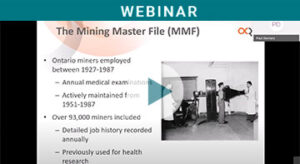Compensation Available for Miners Exposed to McIntyre Powder
If you or a family member worked in the gold or uranium mines in Ontario between 1940 and 1979, you may be eligible for compensation. Funds are available for those who acquired Parkinson’s Disease as a result of their workplace exposure.
See the article in Northern Ontario Business by David Wilken, and contact us for information and services (always free of charge):
TEL: 1-800-461-7120
EMAIL: ask@ohcow.on.ca
OHCOW McIntyre Powder Newsletter
Read the latest information about Research, Medical Updates, WSIB Policies and the official Provincial apology to McIntyre Powder effected miners. NEW ISSUE for MARCH/APRIL!
Introduction
For decades, workers in Ontario mines were required to inhale a substance known as McIntyre Powder before they started their shifts underground. It was believed the powder, composed of aluminum dust, provided protection from lung damage. Since then, many miners who worked during those years suffer from neurological and other physical ailments. The McIntyre Powder Project is a voluntary registry established by the daughter of one of those miners, Janice Martell. It's purpose is to document health issues in those who were exposed to the powder in their workplace and conduct research into the long-term health impacts of aluminum dust exposure. Ultimately, compensation will be sought for those workers who suffered health issues related to their occupational exposure, as well as legislative changes to improve safety in workplaces.
2024 Update
What's Coming Next?
- We plan to conduct extensive worker outreach in 2024-2025 through follow-up phone calls and letters to workers or their next-of-kin, to update your information and determine what further supports we can provide to you.
- We will start the process of reviewing the individual client files of our MP workers who were diagnosed with cardiovascular diseases, to determine if their work exposures, including to McIntyre Powder, may be linked to the development of their cardiovascular disease.
- We will continue to support workers to complete the initial paperwork to start workers’ compensation (WSIB) claims for health conditions related to their mining exposures, and to link them with services from the Office of the Worker Adviser to represent them on claims and appeals.
- We will continue our ongoing work to gather, compile, and review individual client medical and work history records, and to provide individual reports to workers regarding the contribution of their work exposures to the development of their health issues.
Research
The research has been difficult as the miners with the highest levels of Aluminum dust exposure passed away in the early days since the powder was last used. Family genetics, and exposure to Aluminum outside work, might also help explain how work exposures did or did not help to cause a disease. Because Aluminum can be stored in bones and then released years later, lifetime exposures must be explored. Other exposures at work (like other metals or chemicals that are neurotoxic, or acids that may make Aluminum more toxic) are relevant.
OHCOW's Role
OHCOW was invited by the McIntyre Powder Project and the United Steelworkers to participate in intake clinics for exposed workers. Two-day clinics were established in Timmins in May 2016 and Sudbury in October 2016. OHCOW conducted examinations and collected information on the working history and medical backgrounds of miners both living and deceased (with the assistance of their next-of-kin). Ongoing registration of affected miners since 2016 continues through outreach information sessions and telephone intake.
OHCOW staff and physicians reviewed the data with support from other experts to see what current science can reveal, and to decide whether individual medical testing or group research projects could tell more.
Project Partners
The following organizations are partners in the project:
United Steelworkers District 6
Ontario Ministry of Labour, Training and Skills Development
Project Status
Significant administrative work continues in gathering miners’ medical records, WSIB claim files, employment and exposure history.
This information enables our multidisciplinary team to review individual files and investigate the potential work-relatedness of groups of specific health issues found within the McIntyre Powder cluster. Unfortunately, due to record retention schedules, some records no longer exist, making it challenging to proceed further for some workers who died many years ago.
Work with the McIntyre Powder miners continues, and future areas of focus include investigations into a number of sarcoidosis cases, idiopathic pulmonary fibrosis, interstitial lung disease and cardiovascular issues and further work on neurological disorders.
OHCOW RESOURCE
McIntyre Powder & Neurological Disease
February 1, 2021
Paul Demers and other present research by the Occupational Cancer Research Centre linking the powder to neurological damage.
Media Coverage
The following videos/articles are relevant to this study:
The Fifth Estate
The Miner's Daughter [2016]
Miner's Daughter Followup [2017]
The Toronto Star
In human experiment, Ontario miners say they paid devastating price [2017, front page article]
For 20 years, miners sickened by toxic aluminum dust couldn’t file compensation claims. Why? [2018, followup article]
Northern Ontario Business
Miners recall use of black powder during employment [2016]
McIntyre Powder definitively linked to Parkinson’s disease in miners: report [2020]
OHCOW RESOURCE
See More Reports and Additional Resources
A selection of papers, reports and articles relating to miners' health and McIntyre Powder.
Timeline
OCT 2019
A research paper examining the physical characteristics of McIntyre Powder is published by Andrew Zarnke and others. A pilot study at McMaster University is conducted to measure levels of bone aluminum in a group of exposed miners.
MAR 2020
Researchers with The Occupational Cancer Research Centre (OCRC), led by Paul Demers, submit a paper to the WSIB that finds a statistically significant elevated Parkinson’s risk for miners exposed to McIntyre Powder.
AUG 2020
Ontario's Workplace Safety Insurance Board starts approving claims for former miners who were exposed to McIntyre Powder on the job and later developed Parkinson's disease.
JUNE 2022
A paper is published by OHCOW staff Andrew Zarnke with other research partners that reveals the extremely small particle size of McIntyre Powder has potential links to cardiovascular disease, recommending more research.
NOV 2022
Ontario Labour Minister Monte McNaughton gives a long-awaited apology Wednesday afternoon to mine workers who were exposed to McIntyre Powder for over three decades and their families.
DEC 2022
McIntyre Powder exposure is being considered by the Ontario WSIB as a contributing factor to Chronic Obstructive Pulmonary Disease (COPD) development.
Additional Resources
OHCOW has established an interdisciplinary team as part of its ongoing occupational disease cluster work with McIntyre Powder-exposed mine workers.
Exposed miners report multiple diagnoses and/or symptoms related to exposure to McIntyre Powder (aluminum oxide dust) and the mining environment more generally, including cancers, respiratory, neurological, cardiovascular, and other health conditions.
OHCOW Medical consultants and Occupational Hygienists completed literature reviews on issues common to groups of miners.




